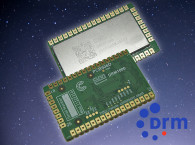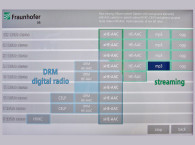
Broadcast technologies are an essential key to the future of digital media, even if no longer bounded by traditional transmission models. One-to-many media content services are a vital part of the streaming media future, as the prevalence of old analog FM radio continues to show and the popularity of podcasting streaming notably demonstrates. The transition to Next-Generation TV services with the ATSC 3.0 standard promises to create a unique opportunity for convergence of digital radio services, no longer bounded by separate broadcasting platforms.
Digital Radio Mondiale (DRM) is the open ITU-endorsed radio standard and the digital successor to the classic analog AM and FM band broadcast services. It offers listeners an innovative next-generation radio experience, based on xHE-AAC – today’s most efficient high-quality audio codec and the latest member of the successful AAC family – and Journaline, an on-demand information service with hybrid interactive functionalities.
While xHE-AAC's efficiency opens up the potential for additional specialized audience channels and pop-up stations, Journaline creates whole new feature applications and revenue potential for broadcasters apart from classic on-air advertisement.
The collaboration of Sinclair and Fraunhofer IIS aims at establishing the seamless transport of DRM based services with all their advanced digital radio features on the ATSC 3.0 TV platform. This allows established DRM broadcasters to create the DRM content once and then distribute it simultaneously via dedicated digital AM/FM transmissions and on the digital TV platform. Listeners can enjoy a seamless and full-featured digital radio experience across all broadcast platforms using any reception device – from stand-alone radio and TV sets to mobile phones and in-car receivers.
"Both the ATSC 3.0 digital TV and the DRM digital radio standards are really gaining momentum all over the world. On air in South Korea since 2017 and with the recently started rollout in the US, the ATSC 3.0 TV standard has proven to be a success. It also receives growing attention in more and more countries worldwide including India. The same holds true for DRM digital radio, which is adopted in a steadily growing number of countries all over the world. Bringing the rich digital radio experience of DRM to the innovative ATSC TV platform is a perfect win-win situation for users and broadcasters alike," says Alexander Zink, Senior Business Development Manager for Broadcast Applications at Fraunhofer IIS.
Sinclair Broadcast Group and Fraunhofer IIS have identified immense potential and significant benefits for all stakeholders resulting from this tight technology integration, which deploys DRM as the common digital radio solution across multiple transmission platforms. A demonstration is currently in preparation to prove the easy transmission of existing DRM based digital radio services over ATSC 3.0, and to showcase the easy integration of DRM reception on ATSC 3.0 receivers, including mobile phones.
This joint project is expected to open the door to close collaboration between the respective standard bodies, the ultimate goal being the adoption of both standards worldwide for the benefit of broadcasters and listeners alike.
"Radio is in everyone’s life on a daily basis. Bringing audio services to the ATSC 3.0 platform with its advanced interactive environment and to our ‘MarkONE’ mobile phone adds new life and opportunities to a timeless medium as well as addressing ‘Direct to Mobile’ market segments easily. With the efficiency of the DRM platform’s xHE-AAC audio codec it is possible to offer hundreds of audio services to answer the needs of diverse audiences and cater for multilingual, multicultural or diverse tastes. And by combining these classic radio services with innovative radio applications such as Journaline, the needs of new market segments can be easily addressed," adds Mark Aitken, SVP of Sinclair Broadcast Group and President of ONE Media 3.0 LLC.
www.iis.fraunhofer.de








